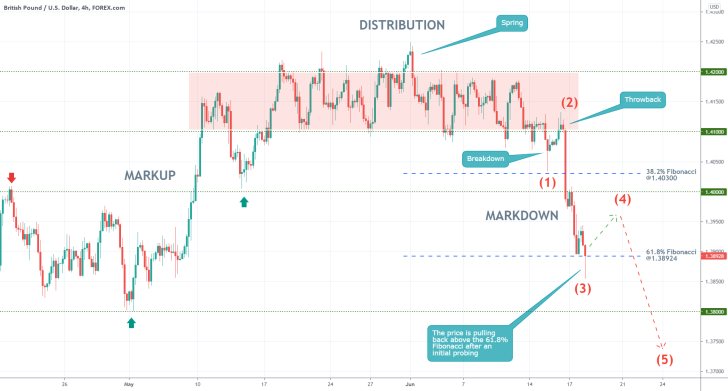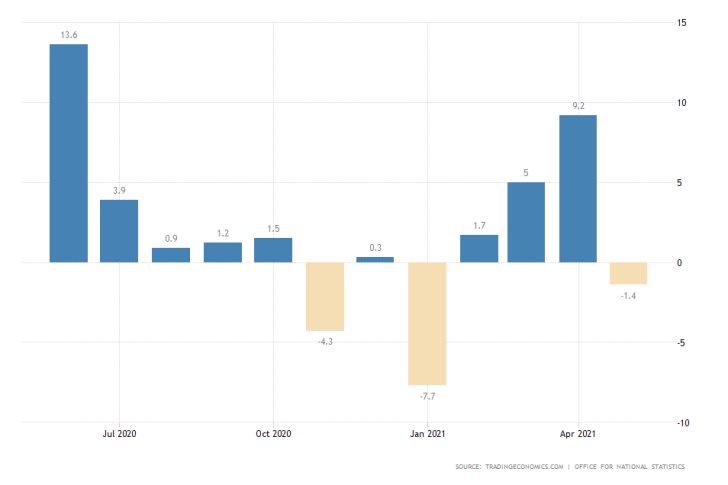
The GBPUSD is developing a new major downtrend, which is emerging from the previous Distribution range. Our last analysis of the pair examined in details the current opportunities for contrarian trading in relation to the Wyckoff Cycle Theory.
The struggles for the GBPUSD were exacerbated earlier today after the Office for National Statistics in the UK published much weaker than initially forecasted retail sales for May. This bolstered the mounting bearish sentiment on the pair.

As can be seen on the 4H chart above, the transition from the preceding Distribution range, as postulated by the Wyckoff Cycle Theory, into a new Markdown was initiated this week. The catalysis was FED's June meeting and FOMC's decision to adopt a slightly more hawkish policy stance.
After the decision was announced, the price action was able to break down below the psychologically significant support level at 1.40000. But even before that, the price action was exhibiting definite bearish signs.
These included the formation of a Spring above the upper boundary of the Distribution, the initial breakdown and the subsequent throwback to its lower boundary.
Notice that the Markdown is taking the form of a classic 1-5 impulse wave pattern, as postulated by the Elliott Wave Theory. The second impulse leg (2-3) appears to be bottoming out near the 61.8 per cent Fibonacci retracement level at 1.38924.
The price action is then likely to establish another bullish pullback, representing the second retracement leg (3-4). Bears would then have the opportunity to utilise contrarian trading strategies at the resulting swing peak.
Disappointing Retail Sales Numbers and Rising Covid-19 Cases
The pound's selling pressure is the result of several external factors happening simultaneously.
Today it was revealed that retail sales had plunged 1.4 per cent in May from the massive 9.2 per cent expansion a month prior. The consensus forecasts were instead anticipating the index to grow by 1.5 per cent.
This monthly performance of the British economy underpins a global trend of weakening retail performance, representing some persisting struggles for the global recovery effort.

Meanwhile, steadily climbing Covid-19 cases are exerting extra pressure on the pound as Britain's economic activity is once again threatened by the risk of renewed government restrictions.
Trendsharks Premium
Gold is undergoing a correction, as investors take profits to offset losses from falling stock prices, impacting their margins. However, we anticipate a renewed wave of [...]
The Swiss stock market index is mirroring its global counterparts, such as Germany 40 and US100, experiencing a sharp decline following the announcement of new [...]
We’re analyzing the weekly chart to grasp the broader market trend. Over the past three years, the US30 index has surged by 17,000 points, often resembling a nearly straight [...]
Over the past week, the DAX has experienced a sharp decline, plunging by an astonishing 3,400 points. This downward movement is not isolated, as its international counterparts, such as the UK100 and US100, are also facing significant [...]
EURUSD recently formed a double top at 1.0930, signaling a potential trend reversal, and has since begun a correction. After a 600-pip rally since early March, a pullback at this stage is both expected and healthy. Given these conditions, we are placing a [...]
Since early March, EURJPY has surged nearly 1,000 pips, providing us with several excellent trading opportunities. However, as the rally matures, many early buyers are beginning to take profits, leading to a noticeable slowdown in the uptrend. On Friday, the pair formed a [...]
The AUDJPY currency pair continues to be dominated by bullish momentum, as multiple golden cross patterns reaffirm the strength of the ongoing uptrend. Despite this, we are witnessing a much-needed [...]
The EURAUD currency pair appears to be undergoing a trend reversal, signaling a potential shift in market direction. A notable technical development is the formation of a Death Cross on the chart, a widely recognized bearish indicator that typically suggests a [...]
After securing an impressive 200-pip profit last week, the EURJPY currency pair is now undergoing a southward correction, retracing some of its recent gains. Despite this temporary pullback, the Golden Cross remains intact, reinforcing our view that the overall trend continues to be [...]
The appearance of a Golden Cross in Silver strengthens our analysis that the metal is currently in a strong uptrend, indicating further bullish momentum in the market. This technical pattern, where the short-term moving average crosses above the [...]
This trade presents a considerable level of risk and can be classified as an opportunistic move based on recent price action. The GBPUSD currency pair has experienced a substantial bullish rally, surging by nearly 500 pips in a strong upward movement. However, after this extended period of appreciation, the pair is showing signs of a potential [...]
The anticipated Death Cross on the SMI20 appears to be failing as price finds strong support at the 23% Fibonacci retracement level. After testing this area, the index has shown bullish strength, printing several large green candles, signaling an increase in [...]
A Golden Cross has just appeared on the USDJPY chart, signaling a potential bullish move. This technical pattern occurs when the 20 period moving average crosses above the 60 period moving average, a widely recognized indication of increasing [...]
After 2 months of a down trend, we finally see some indications of price recovery for Oil. The golden cross, a historic buy signal, supports this [...]
For the past month, the German DAX40 has experienced a remarkable 10% surge, reflecting strong bullish momentum. Despite ongoing market volatility and frequent pullbacks, every dip continues to attract fresh buyers, reinforcing the [...]
Oil continues its downward trajectory, despite occasional pullbacks. The overall trend remains bearish, reinforced by multiple Death Cross patterns, a classic sell signal indicating further weakness. Adding to this bearish outlook, the critical [...]
Over the past few days, gold has experienced a sharp decline of more than $100. This downturn can be attributed in part to traders securing profits to manage their margins, which are under strain due to the significant drop in major indices. Currently, gold has fallen below the [...]
The NASDAQ 100 index is showing strong bullish momentum, as evidenced by the formation of a Golden Cross on the chart. This classic buy signal occurs when the short moving average crosses above the long term moving average, suggesting that upward momentum is [...]
The EURAUD currency pair has encountered a significant resistance level, failing to break above the critical 61% Fibonacci retracement level. This suggests that bullish momentum is weakening, reinforcing the case for a potential downward move. Given this technical setup, we favor entering a [...]
The UK100 is experiencing a remarkable rally! Over the past few weeks, the British stock market index has surged nearly 800 points. Each minor dip has attracted more buyers, fueling the bullish momentum. However, since last week, we’ve observed a slight [...]




















